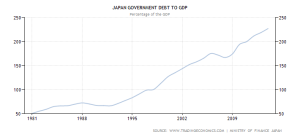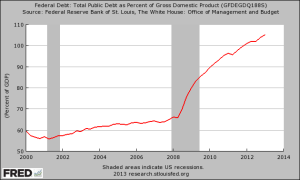Japan’s attempts to pull itself out of its longstanding economic torpor, via heavy government spending and central bank bond buying, is sputtering. Small wonder. This tonic hasn’t worked elsewhere, including in the U.S. Why should it work in Japan?
If a nation were a football team and repeatedly kept running the ball up the middle for a loss, wouldn’t the coach wise up? Evidently not.
The actions of Japanese Prime Minister Shinzo Abe demonstrate that failure vividly. His nostrums are monumentally ineffective.
Japan is formerly the world’s No. 2 economy behind the U.S. Its future couldn’t have been brighter back in the 1980s, when “Japan Inc.” was all the rage. Today, if there really was a Japan Inc., it would have long ago declared bankruptcy. The Land of the Rising Sun has become the Land of the Setting Sun.

“I’d say it’s time to call Abenomics a failure,” according to Jeff Kingston, a professor of politics at Temple University in Tokyo, who was quoted in The New York Times. “The recession means Abe has failed to deliver on growth, and he has whiffed the structural reforms. All that is left is disappointment.”
Japan has followed the United States down the quantitative easing rabbit hole with the same results – a low rate of growth, fewer high-paying jobs and, of course, a booming stock market to cite as proof that quantitative easing works.
Quantitative easing, where the central bank buys bonds to keep interest rates low, is almost always accompanied by government “stimulus” spending. That’s one area where Japan has the U.S. beat – though not by much. That’s difficult to do, considering the $1 trillion-plus budget deficits the U.S. has run since President Barack Obama took office. This year, the U.S. federal deficit is down to a half trillion dollars, but it remains far from being under control.
In Japan, government spending is 42% of gross domestic product, while in the U.S., government spending is over 40% of GDP, according to the 2014 Index of Economic Freedom. Look at the chart above, though, showing the increase in government debt as a percentage of GDP and you may conclude that Japan is the new Greece.
Japan’s government debt has soared from 50% of GDP in 1981 to about 230% today.
So what has all of that government spending and quantitative easing bought? A triple-dip recession, with GDP now falling back to what it was before Abenomics began. Not helping was a hike in the nation’s consumption tax last spring, from 5% to 8%.
Japan’s economy was expected to grow 2.2% in the third quarter. Instead, it had an “unexpected” drop of 1.6%. So has the prime minster concluded that massive government spending and easy money are bad for the economy? No. Instead he’s calling an election to gather public support for more of the same.
“This is getting hard to believe,” says David Stockman, director of the U.S. Office of Management and Budget in the Reagan Administration. “The announcement that Japan has plunged into a triple dip recession should have been lights out for Abenomics. But, no, its madman prime minister has now called a snap election to enlist more public support for his campaign to destroy what remains of Japan’s economy. And what’s worse, he’s not likely to be stopped by the electorate or even the leadership of Japan Inc, which presumably should know better.”
You could argue that the U.S. is in better shape than Japan. After all, federal debt in the U.S. is about 102% of GDP, which is less than half of Japan’s debt-to-GDP ratio. But Japan had a head start with its “lost decade,” its stagnation that began in the 1990s and now is quickly becoming its lost two decades.

And the U.S. is doing its best to catch up. Note that the slope of the U.S. debt-to-GDP ratio is steeper than Japan’s. And it could just be that the U.S. disguises its debt better than Japan. The U.S. chart doesn’t include state and local debt, and it doesn’t include unfunded liabilities for programs such as Medicare and Social Security.
So if Keynesian economics doesn’t work, why are world leaders still relying on it? Why don’t they try other ways of stimulating the economy?
One reason is that doing so would be admitting they are wrong. That just doesn’t happen in politics. Another is that they’re government employees; they’ve been bred for Keynesian economics. It’s all they know. The overriding reason, though, is that more money for government programs means more power. When the government becomes big enough, you can even ignore Congress and rule by executive order.
So government policymakers will continue to follow Keynesian policies until, as Professor Kingston put it, “All that’s left is disappointment.”
Follow AdviceIQ on Twitter at @adviceiq.
Brenda P. Wenning is president of Wenning Investments LLC in Newton, Mass.
AdviceIQ delivers quality personal finance articles by both financial advisors and AdviceIQ editors. It ranks advisors in your area by specialty, including small businesses, doctors and clients of modest means, for example. Those with the biggest number of clients in a given specialty rank the highest. AdviceIQ also vets ranked advisors so only those with pristine regulatory histories can participate. AdviceIQ was launched Jan. 9, 2012, by veteran Wall Street executives, editors and technologists. Right now, investors may see many advisor rankings, although in some areas only a few are ranked. Check back often as thousands of advisors are undergoing AdviceIQ screening. New advisors appear in rankings daily.